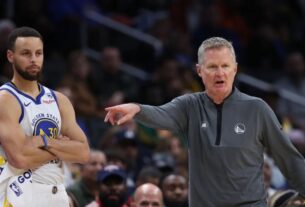Tee Higgins Chooses Falcons Over Ravens in Highly Anticipated Decision
In a shocking and highly anticipated move that has sent ripples through the NFL community, wide receiver Tee Higgins has officially decided to join the Atlanta Falcons, rejecting a competitive offer from the Baltimore Ravens. This move marks a significant shift in the landscape of the league’s receiver market and has massive implications for both teams, their fanbases, and the NFL at large.
Higgins, who is coming off a stellar season with the Cincinnati Bengals, had been one of the most coveted wide receiver free agents of the offseason. After four productive years with the Bengals, including a standout partnership with quarterback Joe Burrow, Higgins tested the open market and quickly became a hot commodity for multiple teams looking to add an elite receiving option to their rosters.
Reports indicate that both the Falcons and Ravens made strong pushes to secure Higgins’ services, with each team offering a mix of financial incentives, long-term potential, and a chance for him to be a central figure in their respective offenses. However, in the end, Higgins has chosen the Atlanta Falcons, a team that has been making waves with its aggressive approach to building a competitive roster in recent years.
At first glance, the Falcons may not seem like an obvious destination for a top-tier wide receiver like Higgins, particularly considering their quarterback situation and a roster still in the midst of a rebuilding phase. However, there are several key factors that likely influenced Higgins’ decision to join the Falcons over the Ravens.
While the Ravens have Lamar Jackson, one of the most dynamic quarterbacks in the league, Higgins may have been swayed by the offensive potential being built around second-year QB Desmond Ridder in Atlanta. Ridder, who showed flashes of promise as a rookie, is expected to take a significant step forward in 2024, especially with the Falcons’ revamped offense and the addition of weapons like Bijan Robinson at running back and a solid offensive line.
The Falcons’ offensive coordinator, Dave Ragone, is known for implementing a system that can accommodate multiple receiving threats, and the addition of a top-tier receiver like Higgins should be a catalyst for the offense’s evolution. The promise of being the centerpiece of an ascending offense with a young, promising quarterback likely appealed to Higgins, who may see this as an opportunity to shape the future of the Falcons’ passing game.
The Falcons have been in a state of flux over the past few seasons, but under head coach Arthur Smith, the team has been laying the foundation for long-term success. Smith, a former offensive coordinator with the Tennessee Titans, is known for his ability to build balanced, productive offenses and get the most out of his players. The Falcons’ front office, led by general manager Terry Fontenot, has shown a commitment to building a competitive roster, particularly in the areas of skill position talent and defensive playmakers.
Higgins may have been drawn to the Falcons’ upward trajectory, which is highlighted by their ability to develop young talent and their plans for an offensive revolution. Atlanta is positioned in the NFC South, a division that has been relatively open in recent seasons, and the chance to help elevate the Falcons into playoff contention might have been a key factor in Higgins’ decision-making process.
Though the financial terms of the deal have not been fully disclosed, reports suggest that the Falcons’ offer was highly competitive, if not more lucrative than the one presented by the Ravens. In a salary cap-driven league, teams often need to make difficult decisions on how to structure contracts to balance their rosters, and the Falcons may have been able to present an offer that struck the right balance between immediate compensation and long-term earning potential.
In addition to the financial package, the Falcons may have presented Higgins with the opportunity to be the focal point of their offense, which is a compelling selling point for a player in the prime of his career looking to maximize both his earning potential and his legacy.
While the Ravens were among the top suitors for Higgins, the reasons for their failure to land the talented receiver are multifaceted.
Although Lamar Jackson remains one of the most electrifying quarterbacks in the NFL, his contract situation has loomed large over the Ravens’ offseason. Jackson signed a five-year contract extension earlier this offseason, but the uncertainty surrounding the team’s offensive system under new coordinator Todd Monken could have made Higgins hesitate. While Jackson’s dual-threat ability is a major draw for many receivers, the consistency of the passing game under Jackson has been a question mark, especially given the team’s ongoing quest to balance its run-heavy attack with the need for a more diversified passing game.
Higgins, who has enjoyed success with Joe Burrow in a pass-heavy, high-powered offense, may have been attracted to the idea of working with a quarterback who could provide more opportunities for him to showcase his skills. The Ravens’ emphasis on a balanced offense and their historically run-heavy attack could have made Higgins feel like his potential to shine as a top-tier receiver might be limited.
Another challenge for the Ravens in securing Higgins’ services lies in their current receiving corps. While the Ravens did make efforts to address their wide receiver room by adding former Notre Dame standout Zay Flowers in the 2023 draft and signing veteran Odell Beckham Jr., their receiving options are still seen as inconsistent when compared to other teams in the league. A player like Higgins, who has the potential to be a true No. 1 option, might have been concerned about competing for targets in a crowded receiving group or dealing with the uncertainty surrounding their offensive system.
The Ravens’ ability to deploy a more pass-heavy offense under Monken could be seen as a positive, but it remains to be seen how quickly the team can transition from its previous identity as a run-first team. Higgins, as a young and talented receiver, likely wanted a situation where he could step in and become an immediate focal point, and the Falcons were simply better positioned to offer him that role.
Despite the improvements the Ravens have made to their receiving corps, the team still has to prove that it can successfully integrate a strong passing game into its overall offensive identity. With a significant focus on the running game and Jackson’s unique style of play, the Ravens are still navigating how to best balance their offensive scheme.
The Ravens’ offense has often been described as “unstable” when it comes to relying on the passing game to get consistent results. While Jackson can make plays with his arm and legs, Higgins may have felt that the Ravens’ offensive style wasn’t a perfect fit for his skills as a traditional outside receiver. While the Ravens could have made a compelling pitch, particularly with their quarterback’s dynamic playmaking ability, it appears that Higgins ultimately found more long-term appeal in joining a system in Atlanta that would feature him prominently in the passing attack.
Higgins’ addition to the Falcons’ roster is a monumental development for the franchise. It gives the Falcons an elite receiver who can stretch the field and provide a consistent, high-level threat in the passing game. This move immediately elevates the team’s offense, especially with the promise of Ridder’s progression as a quarterback.
Higgins’ size (6’4″, 219 pounds) and athleticism make him an ideal complement to the Falcons’ existing skill position players. Running back Bijan Robinson is poised to become the centerpiece of the offense, and with tight end Kyle Pitts and receiver Drake London already in place, the Falcons now possess a formidable group of offensive weapons. Higgins’ ability to take on a primary role in the offense, while also allowing London to develop as a top receiving option in his own right, should help balance the Falcons’ passing attack and give opposing defenses fits.
Moreover, Higgins brings much-needed experience to a relatively young Falcons’ receiving corps, and his leadership will be invaluable in the locker room. As the Falcons look to make a push for the NFC South title, Higgins’ arrival signals that the team is serious about competing for the playoffs and beyond in 2024 and beyond.
For the Ravens, missing out on Higgins is a tough blow, but it doesn’t signal the end of their pursuit of top receiving talent. The Ravens have shown that they are willing to spend in free agency and aggressively pursue key targets, and the addition of another top-tier receiver remains a priority for the team.
With the Ravens still heavily invested in Lamar Jackson and the team’s continued commitment to a balanced offensive approach, they may look to make another move in the coming months to bolster their receiving corps. While the Ravens have plenty of talent on both sides of the ball, their next step will likely be to find a wide receiver who can complement Jackson and provide the team with a legitimate deep threat.
Tee Higgins’ decision to join the Atlanta Falcons over the Baltimore Ravens has sent shockwaves through the NFL, signaling a shift in the balance of power among NFL offenses. The Falcons, with their improving roster and forward-looking vision, have added a true game-changer to their offense. The Ravens, on the other hand, will have to regroup and continue to build around Lamar Jackson in their quest to add more weapons for the franchise quarterback.
For Falcons fans, the addition of Higgins is a clear sign that the team is intent on competing at a high level in 2024. For the Ravens, this decision underscores the challenges of building a balanced and dynamic offensive attack. As the NFL offseason progresses, all eyes will remain on how these two teams adjust and plan for the upcoming season. But for now, Tee Higgins’ choice is the talk of the league, and the Falcons are the big winners.



